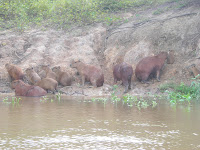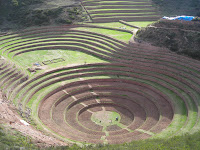

With hours left on our Peruvian visa we headed to the Bolivian border to continue our South American adventure. The border crossing went smoothly and before we knew it we were sipping beers at the beach front of the world´s highest navigable lake at 3,810m, Lago Titicaca in Copacabana, while tucking into some fine trout smeared in a delicious garlic butter, and enjoying the Mediterannian like climate and scenery. It didn´t take long before we were captivated by the spirit of a Bolivian fiesta. A friendly family had just had their car blessed (called a Cha´lla ceremony) and they insisted that we join them for muchas cervezas and dancing in the street. We discovered that Copacabana was the holiest destination in all of Bolivia (as well as the previous Inca empire) and people from the entire continent come here to have all sorts of material possessions blessed or ask for future prosperity. The ceremonies involve a priest giving his blessing to the object (usually a car or lorry, but also models of houses or electronic equipment), the object is then covered in flowers and confetti, as well as small reed boats which capture the spirit of Lago Titicaca and then alcoholic libations are made which is basically pouring beer on the floor. Usually there is enough beer left over for all the participants to get highly inebriated as well! We were also highly amused by Bolivian music which involves a small man smacking a big drum as hard and quickly as he cans while the rest of the band members try and keep up with their brass instruments. Unfortunately, our partying abruptly came to a halt when the military police arrived on the scene and confiscated all our alcohol. We found out afterwards that there was an alcohol ban in force all weekend due to the upcoming election.


Sunday was election day and there was an eerie silence as nothing was open and the usual drone of engines and beeping horns was absent due to the total travel lockdown. We spent the day exploring some nearby Inca sites, hypothesisng about their function and the quantity of sacrificial blood that was spilt. As night fell the first results starting coming in and it soon became clear that Evo Morales, the incumbent indigenous leader, would win a second term by a landslide. The silence was shattered by the first rounds of gun fire. Thankfully, the bullets were directed at the sky and not at any Gringos. A huge fiesta then errupted as brass bands began bashing out their triumphant songs and people gathered crates of cerveza to celebrate. It was a fascinating day and great to see that the election went smoothly in a country with such a troubled political past (Bolivia holds the world record for political coups, 188 in total!).


Once the travel ban was lifted we made the most of our freedom and set off for the beautiful Isla del Sol. After the boat ride we were glad that Bolivia is a landlocked county and cannot subject its visitors to any other sea faring expeditions. It was without doubt the slowest and most painfully boring boat ride we have ever been on. I think they travel at 1 to 2 knots just to save on fuel! A couple of shots of adrenaline to awaken us from our coma were required and then we took on the challenge climbing the long, steep 300 Inca stairs which greet you as you arrive on the Island. We then marched north for three hours along a mountain ridge to get to the best camping beaches and were treated to some spectacular views. On the left, Lago Titicaca shimmered majestically in the evening sun with the Peruvian mainland on the horizon; while on the right, the towering, snow-capped peaks of the Cordillera Real humbled us. With half an hour to go before sunset we found a private, idyllic white sand beach in a cosy sheltered bay. We setup the tent, got a healthy fire going and relaxed as the gorgeous sunset rounded off the perfect setting. As daylight was replaced by darkness the stars came out in all their bright, shining glory. At the same time, distant lightening storms lit up the night sky and we stood in wonder for hours as nature entertained us with its power.

After a few days in Copacabana it was time to venture deeper into Bolivian territory so we set-off for La Paz. Few cities in the world have a setting as unique as La Paz and you can´t help but take in a deep breath when you get your first glimpse of this incredible city. We bused along the barren Altiplano at 4,000m and passed through El Alto, the poorest and most indigenous city in Bolivia, adjacent to La Paz. Then the Altiplano gives way to a massive bowl like gorge with the impressive 6,400m peak of Mount Illimani in the background. Here lies La Paz with houses clinging on to impossibly steep streets (La Paz is also thought to be the most hilly city in the world, which is not a good combo with the high altitude!). We took a while to find some decent accommodation but eventually found a delightful old colonial mansion with a double bed and private bathroom all for GBP 7! It is located in the heart of the witches market, where one can procure all manner of wierd and wonderful potions and good luck charms, including dried llama foetuses to bury in the foundations of your new home!
We have spent a few days in La Paz now and have fallen in love with the city. There are endless market stalls in every direction amidst crumbling colonial splendour where you can acquire anything you want (although probably not on the right side of copyright laws). There is a constant buzz with people caught up in a buying and selling frenzy. I imagine it to be what the old open-outcry system was like in the stockmarket before everything became computerised. The markets of La Paz have perhaps the truest form of free market capitalism, with no hinderance caused by licensing or regulation. It is really refreshing to see this level of freedom after living in the nanny state that the UK has become in the last few years. There is one minor flaw in the master plan and that is the city of La Paz is often held to ransom by the neigbouring city of El Alto which controls the airport and main access roads. Indeed, the politically active citizens of El Alto simply refer to La Paz as ´the hole´and use their geographical advantage to push thier own agenda of agrarian reform and greater indigenous rights.


La Paz is full of comedy and probably none more so than Cholita Wrestling which is a locals favourite involving battles between the feisty Andean women of El Alto. By the end of the night there was popcorn and various other projectiles everywhere and our sides hurt from laughing too much.
Finally, we faced the road of death, apparently the most dangerous road in the world according to the Inter-American Development Bank. We were fortunate to be blessed with a blue sky day and high spec mountain bikes as we braced ourselves for the 3,500m descent over 65km. It was a thrilling day and an unforgettable experience. Rather than heading back to La Paz with the rest of the group we found refuge in Coroico, which is a delightful jungle town whose slogan is ´Welcome to Paradise´. We found a relaxing, German-owned hippy retreat and have spent today lounging around the pools and counting butterflies. Life is good!




















































